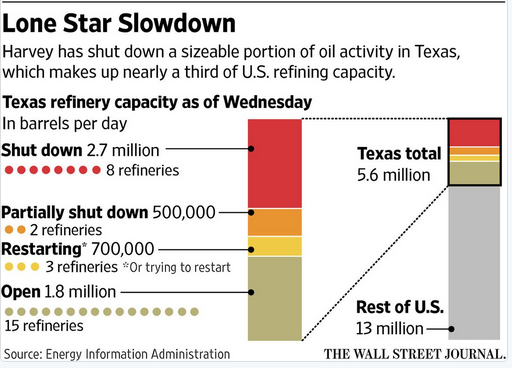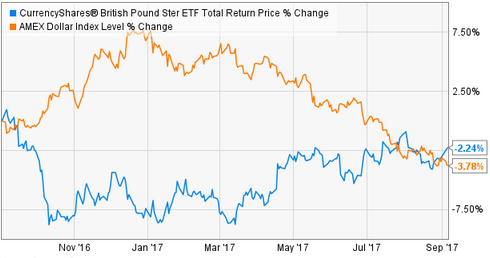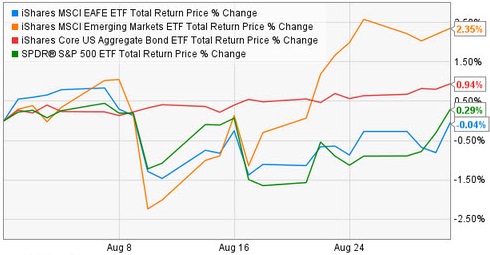It’s hard to stay focused on a lot of things, including the markets, in the face of the human tragedy like what we’ve witnessed from Hurricane Harvey and its aftermath over the last few weeks in South Texas, in the greater Houston area, and into Louisiana. For the people who lived through it, the storm is over, and now it’s time to clean up and get back to living. For those that lost loved ones, we offer our thoughts and prayers. Many have now embraced the opportunity to pitch in and help however we can - with our time and our money. We seem to complain a lot about the negatives associated with new technology in our world today – the incessant distraction of “screen time,” etc. - but one of the great things about new technology is how it’s made contributing to worthy causes easier than ever. With just a few clicks you can give to any one of several great charities. So, please find here a short list of charities that could really use your help right now. If you’ve already given, thanks. If you want to give or give again, just click on any one of the live logo links listed here:
The destruction, especially from the flooding in the greater Houston area, is unimaginable. More than 75 people are dead or missing; another 30,000 people have been displaced; and the winds and floods have inundated hundreds of thousands of homes and businesses, prompting more than 17,000 rescues. Two weeks ago, when Harvey was still churning in the Gulf of Mexico, few could have imagined how much destruction this storm would do. But the “perfect storm” pieces started falling into place as Harvey plodded toward the Texas coast. It began intensifying, and its slow pace had the models of weather experts forecasting the increasing possibility of devastating precipitation.
The damage was worse than what anyone had predicted. Over a four-day period, many areas received more than 40 inches of rain as the system meandered over eastern Texas and adjacent waters, causing catastrophic flooding. With a peak accumulation of almost 52 inches in Cedar Bayou, Texas, a small town just east of Houston, Harvey became the wettest tropical cyclone on record in the contiguous United States. The local National Weather Service office in Houston observed all-time record daily rainfall accumulations on both August 26 and 27, measured at 14.4 inches and 16.08 inches respectively. The 39.11 inches of rain in August made the month the wettest ever recorded in Houston since record keeping began in 1892, more than doubling the previous record of 19.21 inches in June 2001. The Brazos River, which puts nine times as much water through it as the Rio Grande, at one point was putting 45-60 times as much water through, around 70-80,000 cubic feet per second. That’s about the same amount of water found in an Olympic-sized swimming pool.
It’s easier to understand now how this mind-boggling amount of rainfall completely overwhelmed the Houston area’s rivers and reservoirs, and how at one point an estimated 25–30% of Harris County - roughly 444 square miles of land – was under water. FEMA director Brock Long called Harvey the worst disaster in Texas history, and the recovery is expected to take many years. Harvey could wind up being the most expensive natural disaster in American history, costing the economy an estimated $190B, which would total more than Katrina and Sandy combined.
 As can be imagined, when the fourth-largest city in the U.S. succumbs to a Category 4 hurricane, the impact is felt elsewhere. Oil and gas production in the Gulf of Mexico and oil refineries in the Houston area were scaled back ahead of Harvey, reducing capacity and creating an artificial fuel shortage. Panicked motorists swarmed gas stations throughout Texas, causing many locations to run out of fuel temporarily. Nationally, gasoline prices have risen an average of 17 cents a gallon since Harvey made landfall and now average $2.45, according to AAA. Flood waters caused a chemical plant outside of Houston to lose power, preventing compounds from remaining refrigerated, which sparked a chemical fire. The threat of toxic pollutants being released into the air and drinking water is a real concern, but health department officials are overwhelmed and can’t perform the necessary sampling yet.
As can be imagined, when the fourth-largest city in the U.S. succumbs to a Category 4 hurricane, the impact is felt elsewhere. Oil and gas production in the Gulf of Mexico and oil refineries in the Houston area were scaled back ahead of Harvey, reducing capacity and creating an artificial fuel shortage. Panicked motorists swarmed gas stations throughout Texas, causing many locations to run out of fuel temporarily. Nationally, gasoline prices have risen an average of 17 cents a gallon since Harvey made landfall and now average $2.45, according to AAA. Flood waters caused a chemical plant outside of Houston to lose power, preventing compounds from remaining refrigerated, which sparked a chemical fire. The threat of toxic pollutants being released into the air and drinking water is a real concern, but health department officials are overwhelmed and can’t perform the necessary sampling yet.
Still, there are signs that the Houston area and South Texas are already starting the long path to recovery. Houston’s mega-shelter at the NRG Center near downtown sheltered about 10,000 victims only days ago. Now that number is down to only 2,800. Victims are being consolidated from smaller shelters in the area, and many others have returned home. Houston Mayor Sylvester Turner said much of the city was hoping to get back on track after Labor Day, encouraging anyone who had plans of attending a conference, convention, sporting event or concert in Houston to keep their plans. Federal, state and local agencies are already starting the process of making capital available to victims of Harvey, and the Small Business Administration has announced plans to give out thousands of disaster recovery loans worth billions of dollars to rebuild Houston and other Harvey-hit areas.
Again, our thoughts and prayers go to all those affected by Harvey and to those preparing for Hurricane Irma. Now let’s spend some time looking at what’s been going on in the world.
US ECONOMY
Growth for the U.S. economy was recently revised higher, which could also be a tailwind for stocks going forward. The U.S. economy grew at a 3% annual pace in the second quarter of 2017, an upward revision from the 2.6% pace reported in July. Spending was robust by both consumers and businesses in Q2, with capital expenditures expanding at an 8.8% rate — the fastest in nearly two years.
INTERNATIONAL
The forecast for an uptick in U.S. economic growth is being mirrored in other economies as well. For the first time in ten years, all of the world’s major economies are forecast to grow. All 45 countries tracked by the Organisation for Economic Co-operation and Development are on track for GDP expansion in 2017, and 33 of them are forecast to post stronger growth than they did in 2016.
The expected economic strengthening in Europe is helping to prop up its currency. The euro continues to rally, hitting its highest level against the dollar since just before the European Central Bank announced its stimulus program in January 2015. Driving the euro’s gains: growing expectations that the ECB will begin tapering its monthly €60 billion ($71.3 billion) of bond buying as it runs out of assets to purchase. The euro is already up 13% against the dollar in 2017. 
Conversely, uncertainty surrounding the United Kingdom’s (UK) Brexit campaign is weighing on the pound sterling. The third and latest round of Brexit negotiations between the European Union (EU) and the UK ended on an acrimonious note, with the two sides unable even to agree on whether any progress had been made during the week. There has been no agreement on key issues such as the Northern Ireland border, citizen’s rights and the size of the Brexit divorce payment. The EU has stated that sufficient progress must be made on those issues before discussion of the UK’s future trade relationship with the EU can be taken up. Sterling slipped almost 2% in August versus the US dollar, its worst month since December. In emerging markets news, manufacturing in China continues to surge. Total new business grew at the strongest rate in more than three years, while export orders saw the sharpest increase in over seven years, pointing to strong demand at home and abroad.
STOCKS
The U.S. stock market (the S&P 500) was up and down in a topsy-turvy August, with the market finishing the month in the black, but just barely. Low trading volumes likely exacerbated market volatility, as many traders often take a break for vacations in August. Losses piled up in the first half of August due to a host of factors - worries over escalating tensions between the U.S. and North Korea, the terrorist attack in Barcelona, the Fed’s uncertainty, and fears that the Trump administration’s economic and business strategies are splintering.
As volatility spiked, many investors flocked to perceived safe havens like bonds, gold and utility stocks, which many consider the stock market’s bond proxy because of their hefty dividends. In fact, utility stocks were the best-performing market sector in August. Meanwhile, the energy sector’s slump deepened as the Gulf Coast oil industry took a heavy hit from Harvey. But U.S. markets began their rebound in the back half of August as positive news on earnings and economic data rolled in, helping the S&P 500 once again extend its streak of monthly advances to five.
CENTRAL BANKS
In central bank news, the U.S. Federal Reserve Open Markets Committee (“the Fed”) appears split over the timing of their next rate hike. Minutes from the Fed’s July meeting reveal the group is worried about soft inflation numbers, but officials also agreed to begin the shrinking of the central bank’s holdings soon, perhaps in September. While U.S. job growth likely slowed in August after two straight months of robust gains, the pace of increase should be more than sufficient for the Fed to start shrinking its massive bond portfolio. However, Fed Chair Janet Yellen offered no clues about any policy shifts or further interest-rate increases while speaking at an economic symposium in Jackson Hole, Wyoming last month. Instead, she focused on defending regulations enacted following the financial crisis of 2008.







